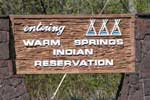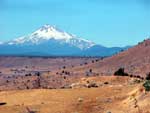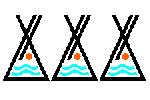Mishnam au way,
Qengi maita,
Ha-oo-u
We welcome you to our country. The common greetings (above) are loosely translated, "how are you doing?" Each is written in one of the three native languages spoken on our reservation: Ichishkiin - Warm Springs, Kiksht - Wasco, and Numu - Paiute. We are the peoples of the Confederated Tribes of Warm Springs - the families and bands of the Warm Springs, the Wasco, and the Northern Paiute Indians. In the pages of this module we wish to share with you some of our rich, varied, and living heritages.
 | | Welcome to the Confederated Tribes of Warm Springs Reservation. |
Today we number 4,233 tribally-enrolled members (2003). Most of our homes are on the Warm Springs Reservation of Oregon. It is a reservation of over 650,000 acres, an area much smaller than our original territory. The land is as diverse and rich as the peoples who reside on it. There are rivers teeming with salmon, high desert plateaus flowering with seasonal beauty, dense old-growth forests alive with deer and elk, and distant vistas looking out onto the ancient volcanic Mount Jefferson, the Three Sisters, and Mount Hood.
The Wasco bands traditionally lived along the southern banks of the Columbia River, with villages from the Great Narrows, near The Dalles, down river past the Hood River. See map. Our bands are known as the People of the Narrows (The Dalles), the Dog River, and the Ki-gal-twal-la bands. We had many villages along the river, one of which was located where the city of The Dalles now stands. We resided in permanent, year-round wooden homes in villages along the river, where we fished for the salmon and traded fish, roots and other goods with other tribes from throughout the region. Our language is Kiksht, a Chinookan lanugage, closely related to the Cascades and Clackamas Chinookan dialects.
 | | Mount Jefferson. |
The Warm Springs families come from the bands of the Tyghs, the Wyams, the Tukspushes, and the Teninos, who formerly lived along the banks of the Columbia River, as well as the John Day and Deschutes rivers. See map. While we relied upon and fished for the salmon, we also moved our villages with the changing seasons, to dig roots on the high plateaus, and to gather berries and hunt in the nearby mountains. We speak Ichishkiin, a Sahaptin language, similar to that spoken by our relatives, the Yakama and Nez Perce, who live upriver.
Our Northern Paiute families traditionally lived well south of the Columbia River, in a vast territory of the Great Basin, a high plateau country, which included southeastern Oregon, into northern Nevada, southwestern Idaho and western Utah. Some families seasonally-traveled into the upper reaches of the Deschutes and John Day rivers to gather foods. See map. Our ancestral Paiute familes moved extensively with the seasons, to dig roots, gather berries and willows, hunt deer and other game animals, and fish the rivers of the region. Compared with our Wasco and Warm Springs familes, salmon was less important to the way of life of the Paiute people. Our Paiute language is Numu, a Shoshoean dialect, related to other tribes such as the Shoshone and Bannock of Nevada, Utah and Idaho.
While each of our traditions and languages may vary from one another, we share a common love and stewardship of the lands, the rivers and mountains we now live upon, and a strong desire to pass on our living heritages to the future generations and to share them with you.
To go to the following Subject Topics:
© Confederated Tribes of Warm Springs 2003
|
next > |





 28K 56K 256K
28K 56K 256K



